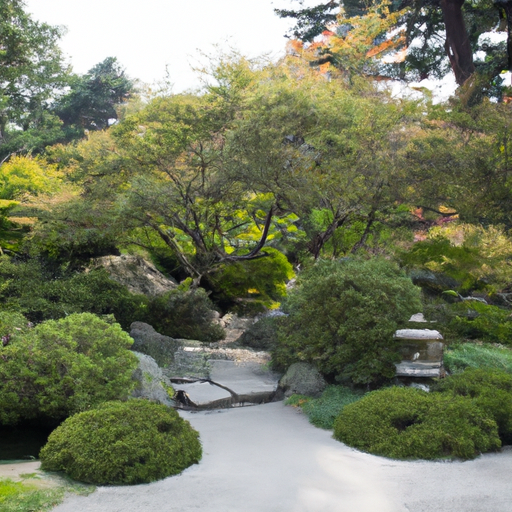Embark on a visual journey through the expansive realm of Japanese gardens. The article, “Mapping the Garden: The Art of Japanese Garden Layouts,” presents an immersive exploration of Japan’s venerable tradition of creating intricately designed gardens. This piece is set to unfurl the rich tapestries of Japanese garden art – exploring their meticulous creation, history, cultural context, and their undeniable allure that transcends borders and time. It’s time for you to immerse yourself in the delicate dance between nature and human creativity, in the magical world of Japanese garden layouts.
Origin and History of Japanese Gardens
Introduction to Japanese Gardens
When you imagine serene scenes of nature, tranquility, and calmness, a Japanese garden might come to mind. Japanese gardens blend simple, natural elements like water, stones, plants, and structures to create not just a beautiful landscape, but a retreat for the mind and soul. They are carefully crafted designs grounded in religious and philosophical ideals, subtly conveying deep meaning and a sense of harmony.
History of Japanese Gardens
The history of Japanese gardens dates back to the Asuka Period (6th-8th centuries) when Japanese people first embraced the influence of Chinese gardening techniques. Over time, these gardens evolved, and new styles were introduced, influenced by different historical periods, social transformations, and religious philosophies. Large-scale imperial gardens, peaceful Zen temple gardens, and practical tea garden styles are all part of this rich and varied history.
Cultural Significance and Influence
Japanese gardens are more than decorative landscapes; they’re embodiments of Japanese culture and philosophy. Drawing from Shinto, Buddhist, and Taoist philosophies, these gardens effortlessly blend the natural world, spirituality, and artistry. They represent ideals such as harmony, balance, and transience, subtly encouraging observers to reflect upon their lives philosophically.
Elements of a Japanese Garden
Rocks and Stones
In a Japanese garden, rocks and stones represent permanence and stability. They are often used to mimic natural landscapes like mountains or water bodies like flowing rivers. The careful placement of these elements often follows the principle of ‘san son’ – using three or multiple stones in clusters to form cohesive units.
Water Features
Water is another key element in Japanese gardens representing purity and the flow of life. It can be actual, like a flowing stream or pond, or implied, such as a dry riverbed of small stones. The sounds created by moving water, like a babbling brook or waterfall, also have a therapeutic effect and aid in achieving tranquility.
Plants and Trees
Plants – from mosses and grasses to larger shrubs and trees – are used extensively to add color, texture, and seasonal variety to gardens. They often symbolize different aspects of life. For example, evergreen trees signify eternal life, while cherry blossoms remind one of the fleeting nature of existence.
Lanterns and Other Structures
Structures like stone lanterns, bridges, gates, teahouses, and even pagodas add to the aesthetic and symbolic appeal of Japanese gardens. These elements not only serve practical purposes, but also hold significant meanings; for example, bridges are thought to symbolize the path to paradise and immortality.
Garden Layout and Design Principles
Balance and Harmony
One of the fundamental design principles of a Japanese garden is achieving a sense of balance and harmony. This balance is achieved not through symmetry, but through intricately weaving contrasting elements together in a way that feels natural and congruent.
Symbolism and Metaphor
Japanese gardens are rife with symbolism and metaphors, from the choice and placement of rocks to the types of plants used. Every element signifies broader concepts, like islands standing for paradise or a tortoise-shaped rock symbolizing longevity.
Miniaturization
Another artful technique used in Japanese gardens is miniaturization. Large landscapes, such as mountains and seas, are imitated in a smaller scale to give viewers a sense of vastness and the unity of nature.
Enclosure
Enclosure is a crucial element in instilling a sense of tranquility and seclusion in a Japanese garden. High walls, bamboo fences, or strategically placed plants can create this intimate space.
Use of Space
Japanese gardens make full use of empty space or “ma” to create depth, contrast, and balance. The emptiness can be filled with air, water, or even shadows, and plays a crucial role in the overall composition and feeling of the garden.
Types of Japanese Gardens
Rocks Gardens (Karesansui)
Also known as Zen gardens, Karesansui gardens use rocks, gravel, and sand instead of water to depict miniature landscapes. Raked patterns on gravel often represent ripples on water, facilitating meditation and introspection.
Tea Gardens (Roji)
In Roji, or tea gardens, every element is carefully selected and placed to prepare visitors spiritually and mentally for the tea ceremony. Typical features include a rustic teahouse, stepping stone paths, and stone lanterns.
Stroll Gardens (Kaiyu-shiki)
Walking through a Kaiyu-shiki garden is like embarking on a journey. Visitors stroll along winding paths, experiencing varied landscapes, islands, and views, often punctuated with ponds and bridges.
Pond Gardens (Chisen-shoyū-teien)
These gardens are focused around a central pond and often reflect the pure land paradise described in Buddhist scriptures. They typically feature an island in the pond, a waterfall, and a variety of plants and stones.
The Art of Siting in a Japanese Garden
Choosing the Location
The natural environment where a garden is located plays a pivotal role in Japanese garden design. Factors like topography, climate, and native vegetation are considered while choosing a location, allowing the garden to integrate seamlessly into its surroundings.
Orientation of the Garden
the orientation of the garden in relation to the sun, wind, and surrounding views can greatly affect the garden’s atmosphere. Designers are aware of these elements to ensure the garden interacts harmoniously with its environment.
Interactions with Surrounding Environment
Japanese gardens reflect a deep respect for nature. They aim to enhance, not override, the natural environment. Elements of the surrounding landscape, like distant mountains or old trees, are often incorporated into the garden’s design.
Tools and Techniques for Garden Mapping
Traditional Japanese Garden Mapping
Traditional Japanese gardens were designed with intricate hand-drawn maps. These maps, with their careful measurements and annotations, formed the basis of the garden’s layout, showing not just the physical elements, but also their symbolic meanings.
Modern Methods and Tools for Garden Mapping
Modern methods of garden mapping often utilize digital technologies like 3D modeling and CAD (Computer-Aided Design) software. These tools provide more precise renderings and measurements, and allow for virtual walkthroughs of the proposed garden space.
Maintenance and Care for Japanese Gardens
Routine Care and Maintenance
Like any garden, Japanese gardens require regular care. From pruning plants and trees to repairing structures and cleaning water elements, routine maintenance is vital to keep the garden in harmonious balance.
Seasonal Considerations
The changing of seasons also requires special care in a Japanese garden as the links between the seasons and nature are deeply revered. Early spring might see careful nurturing of budding blossoms, while fall may require cleaning fallen leaves.
Pest and Disease Control
Being natural spaces, pests and diseases can be an issue in Japanese gardens. Integrated pest management and the use of organic solutions are prevalent, keeping in line with the utmost respect for nature that is central to the garden’s ethos.
Influence of Zen Buddhism on Japanese Garden Design
Philosophy of Zen
Arguably, no other philosophy influences Japanese gardens as deeply as Zen Buddhism. Zen principles emphasize simplicity, naturalness, and austerity. These tenets are often reflected in the understated elegance, minimalistic design, and use of natural, unadorned elements in the garden.
Influence on Garden Layout and Design
From the restrained beauty of rock gardens to the tranquil atmosphere of tea gardens, Zen principles have heavily influenced the layout and design of Japanese gardens. Elements are chosen and placed to evoke subtle feelings and provoke thoughtful introspection.
Zen and the Japanese Tea Garden
The Japanese tea garden is a clear manifestation of Zen influence. Every aspect of a tea garden, from its layout and elements to the tea ceremony itself, is infused with Zen philosophy. They are places of meditation and spiritual refinement.
Anatomy of a Tea Garden
Role of the Roji in the Tea Ceremony
In the context of the tea ceremony, the Roji (tea garden) serves to transition guests from the outside world to the spiritual world of tea. The journey through the tea garden is a cleansing process, preparing the guest for the serenity of the tea ceremony.
Elements of a Tea Garden
Typical elements of a tea garden include a waiting area, a stone basin for ritual purification, a teahouse, stepping stones, and lanterns. Each of these elements is mindfully placed and serves a particular purpose in the tea ceremony.
Layout of a Tea Garden
The layout of a tea garden is planned to emphasize humility, simplicity, and tranquility. Narrow paths, rustic elements, and soft plantings contribute to the introspective experience of walking through a tea garden.
Japanese Gardens Outside Japan
Spread and Influences
Japanese garden design has made its way across the globe, bringing elements of Japanese culture, aesthetics, and spirituality to various corners of the world. These gardens outside Japan reflect the universal appeal of their design principles and the human desire for serenity and connection with nature.
Examples of Notable Japanese Gardens Globally
There are numerous examples of stunning Japanese gardens outside Japan. From the Japanese Tea Garden in San Francisco to the Portland Japanese Garden in Oregon and Kew Gardens in London, these properties embody the elegance and tranquility of traditional Japanese gardens.
Challenges in Creating Authentic Japanese Gardens Abroad
While Japanese gardens abroad can capture the visual appeal of the original style, recreating the deeper cultural and philosophical nuances can be challenging. factors like climate adaptability, availability of necessary materials, and understanding of subtle Japanese aesthetics can also pose challenges to authenticity. However, these obstacles can often be overcome by careful planning, sensitivity to local conditions, serious study, and, ideally, the guidance of an expert in Japanese garden design.








